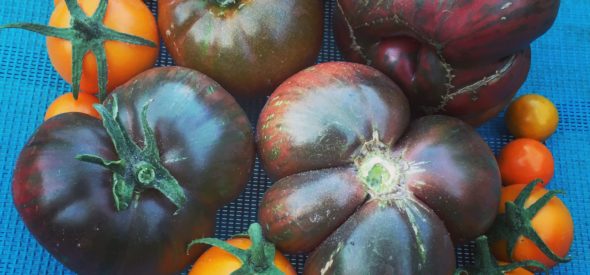TOMATO GROWING TIPS
0May 12, 2019 by Hope Gardens

There’s LOTS of ways to grow your tomatoes but in our suburban/urban gardening experience this is what works and can simply be explained in 700 words.
HOPE GARDENS TOMATO GROWING TIPS
Congratulations on adopting your tomato seedling! Soil is the key to all vegetable planting. Get a bag of organic potting soil for your tomatoes. Fabric pots are lightweight yet durable containers. You can even use a clean paint bucket or a plastic storage container as long as you drill some drainage holes in the bottom. Plant one tomato seedling per pot.
Before planting, mix an organic fertilizer into the soil. Tomatoes need more phosphorous than nitrogen and lots of calcium. Coffee grounds and egg shells are great in the composter, they are not great applied directly to your tomato plant. Tomatoes will need more fertilizer every month and can use a dose of diluted liquid fertilizer applied to their roots and/or leaves every two weeks. Always water well after using dry fertilizer to activate the fertilizer in the soil. Organic vegetable fertilizer can be bought pre-mixed. You can also add Azomite, Kelp Meal, Bone Meal, Oyster Shell Flour, Soft Rock Phosphate and in diluted liquid form, Fish Emulsion and/or Seaweed. Compost and worm castings are wonderful amendments too. Hope Gardens no longer supports animal products in their gardens or fertilizers. If you need a hookup for a vegan fertilizer, give us a shout at yourhopegarden@gmail.com.
Tomatoes love heat and need 6-8 hours of full sun. If they get full sun from morning till evening, covering them with a light sheet or row cover cloth when temps soar above 90 degrees will protect the fruits. Tomatoes can grow roots along the stem which is helpful because they need strong roots to hold up their heavy fruits. To this end, remove the bottom TWO rows of leaves from your seedling before transplanting and bury the seedling very deep up to the next set of leaves. (Some of your Hope Gardens seedlings may have already been trimmed for you.) Also remove any flowers on your tomato plant (I know it’s hard to do!) so the plant transfers energy into setting roots, rather than fruits. Your plant will re-fruit soon and be all the better for it. Finally, DO NOT disturb the roots of your seedling. Transfer it carefully to it’s new home and press firmly on the soil around the seedling.
Tomatoes love company. Plant your tomato with flowers (marigold, cosmos, sweet alyssum, nasturtium, etc.) and herbs (parsley, dill, basil, cilantro, etc.) to provide a healthy environment for your seedling. Do not however bury your tomato among your other large plantings. Leave room between plants for air to circulate and sunshine to reach it. Avoid soil-borne diseases – don’t plant your tomatoes in the same tomato soil you did last year. And try to water the soil, not the plant.
Pruning tomatoes is a hotly debated issue. Pinching off “suckers” (branches that grow in the armpit of a leaf stem and your main stalk) will keep your plant tidier and direct energy to stronger stems. Over-pruning can leave your fruits vulnerable to sun scald as leaves provide protection. Definitely remove and throw away any stems/leaves that look diseased or withered. As the plant grows, remove any bottom leaves that touch the ground.
To spAn organic fungicide applied every 2-4 weeks will go a long way in keeping your plants healthy. Search your plants for bugs, especially green caterpillars. The best control method is to hand-pick those buggers off – sorry to say – but they are super destructive. For aphids and smaller bugs, try a handmade or store-bought soap spray.
Stake your plants so the branches don’t break under the weight and fruit doesn’t rot on the ground. You can use redwood or bamboo stakes or cages. If using cages, install as soon as you plant the tomato. Green stretchy garden tape is the best for attaching stems to stakes.
Water deeply every other day in the summer and check your plants for bugs, disease and to stake them. Side dress plants with dry fertilizer once a month and foliar feed every week or two. Harvest your fruits earlier rather than later. If animals tend to steal your tomatoes or a branch breaks leaving you with some green tomatoes, let them fully ripen indoors. Remember “the best fertilizer is the shadow of the gardener” so get out there!
Need more help? That’s what we’re here for! Check out our veggie gardening workshops and all the tips on my website to learn more. You can also contact us directly at yourhopegarden@earthlink.net. Happy gardening, garden warriors!
Category DIY Garden Guides, Vegetable gardening | Tags: containergardening, Garden, gardening, Harvest, heirloom, Heirloom tomato, homegrown, organic, permaculture, raised bed, raised bed garden, raised bed gardening, raised beds, raised garden bed, Tomato, urban farm, Vegetable, vegetable beds, Vegetable Garden, vegetable gardening, veggie


